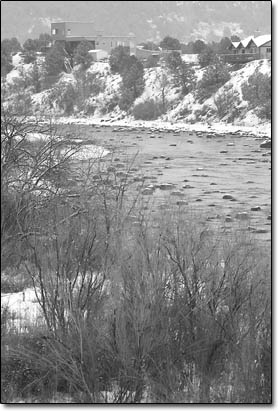|
Legislation could aid $72 million project
by Will Sands
 |
The Animas River flows past
houses near La Posta Road on its way to New Mexico. Legislation
is being considered that would create a pipeline from Ridges
Basin Reservoir and siphon Animas River water to the Dry Side./Photo
by Todd Newcomer. |
Another major La Plata County water project is looming on the
horizon. Supplying drinking water to La Plata County’s Dry
Side is part of the motivation for a current push before the U.S.
Senate to give the Bureau of Reclamation sweeping new powers.
If the push is successful, the first product of the new legislation
could be a $72 million water treatment facility and pipeline serving
western La Plata County and northern New Mexico.
New Mexico resident Jim Dunlap is a man who wears many hats.
He is a rancher that serves as the Chairman of the Interstate
Stream Commission, is the vice-chair of the San Juan Water Commission
and sits on the boards of the Upper La Plata Water District, the
New Mexico Rural Water Association and the National Rural Water
Association.
“I’ve been just about everything there was,”
Dunlap commented.
Dunlap had been scheduled to appear before the Senate Committee
on Energy and Natural Resources on Nov. 13, 2003, to offer testimony
on two Senate bills that would enhance drinking water supplies
for rural families. The bills would in effect get the Bureau of
Reclamation, an agency noted for ambitious public works projects
like Animas-La Plata, involved in rural water development. However,
a two-day filibuster prevented Dunlap’s statement and any
progress on the bills.
Directly tied to Dunlap’s testimony is a renewed local
push to provide a drinking water system to residents on the Dry
Side including western La Plata County and northern San Juan County.
“There are people who have hauled drinking water all of
their lives that live on Red Mesa,” Dunlap said. “It’s
bad. We’re looking for a solution to try to provide water
for the people who live over there.”
Five days after Dunlap had been scheduled to make his statement,
the Bureau of Reclamation released a draft study on creating a
Southwestern La Plata County rural water system. The draft outlines
a system that would begin with a water treatment plant on the
west side of the Animas-La Plata Project’s Ridges Basin
Reservoir. From the treatment plant near Wildcat Canyon, a series
of storage tanks and a pipeline would siphon water out of A-LP
and transport it southwest to and over the New Mexico line. Residents
along the greater Red Mesa area and in northern San Juan County
would be the project’s major beneficiaries. The estimated
cost of the system is $72 million, according to the study. The
study also states that residents north of Breen and current Lake
Durango customers like Durango West and Rafter J could also tap
in to the system, but that cost was not included as part of the
estimate.
“It’s primarily for the Red Mesa area of the Dry
Side that doesn’t have any drinking water of its own,”
Dunlap explained. “There would be a treatment plant southwest
of the A-LP reservoir, and lots of piping would have to be put
in because it’s going to be a big system.”
However, Dunlap assured that big systems are the wave of the
future and would be most appropriate for the Dry Side and rural
projects in general. “Northern New Mexico now has 10 rural
water districts centered around this general area,” he said.
“It’s much more efficient to make a large regional
system.”
Longtime opponents of the Animas-La Plata Project see nothing
efficient about the proposed system. In fact, Steve Cone, A-LP
coordinator for the Citizens’ Progressive Alliance, said
the proposed legislation could set a dangerous precedent and not
just for La Plata County. He said the ability to kick off rural
water planning on a grand scale would be environmentally damaging
and harmful to taxpayers.
 |
Homes such as this one in the Shenandoah
subdivision, which is served by Lake Durango Water Co., could
become the beneficiaries
of a proposed pipeline that would siphon water from A-LP to
the county’s Dry Side./Photo by Todd Newcomer. |
“This legislation is designed to grant the Bureau of Reclamation
new and unprecedented powers to expend federal funds for environmentally
damaging and fiscally irresponsible projects,” he said.
“Up to 80 percent of the construction costs of this project
would be federally subsidized.”A0
The funding mechanism is a concern shared by Michael Black of
the Taxpayers for the Animas. “The people who are benefiting
from this4 should be paying for it,” he said.
Cone also questioned whether it is in the public’s best
interest to enable people to live in naturally arid areas like
the Dry Side.
“It is the public who should decide what should be done
with the water supply and who should pay for it,” he said.
“To determine that it’s the public’s responsibility
to pay for people’s decisions to live in remote areas is
pretty shaky.”
Phil Doe, of the CPA, concurred that the pipeline is of questionable
benefit to the public at large. “All it will do is get the
taxpayers to pay for building the water supply for 35-acre ranchettes,”
he said.
Doe and Black both agreed that the construction of a $72 million
treatment plant and pipeline essentially resurrects the original
A-LP project both physically and financially. Black referenced
recent A-LP cost overruns and said, “In other words they
are building the whole A-LP project, and it’ll cost just
as much as the original estimate because you know that $72 million
is going to double like everything else.”
Doe commented that the La Plata component of A-LP was cut as
part of the compromise coined A-LP Lite. He remarked that this
new rural water supply would not only bring the La Plata back
into A-LP and erase the compromise, it would shift the expense
of doing it onto the American taxpayer.
“They cut it out and called it a compromise,” he
said. “Now, they’re trying to get it back, and they’re
trying to get the taxpayers to cover the cost of it.”
For his part, Dunlap is putting the November filibuster behind
him and looking forward to making his statement before the Senate
Committee on Energy and Natural Resources this spring. He said
he expects to be in the nation’s capital in early March.
|

